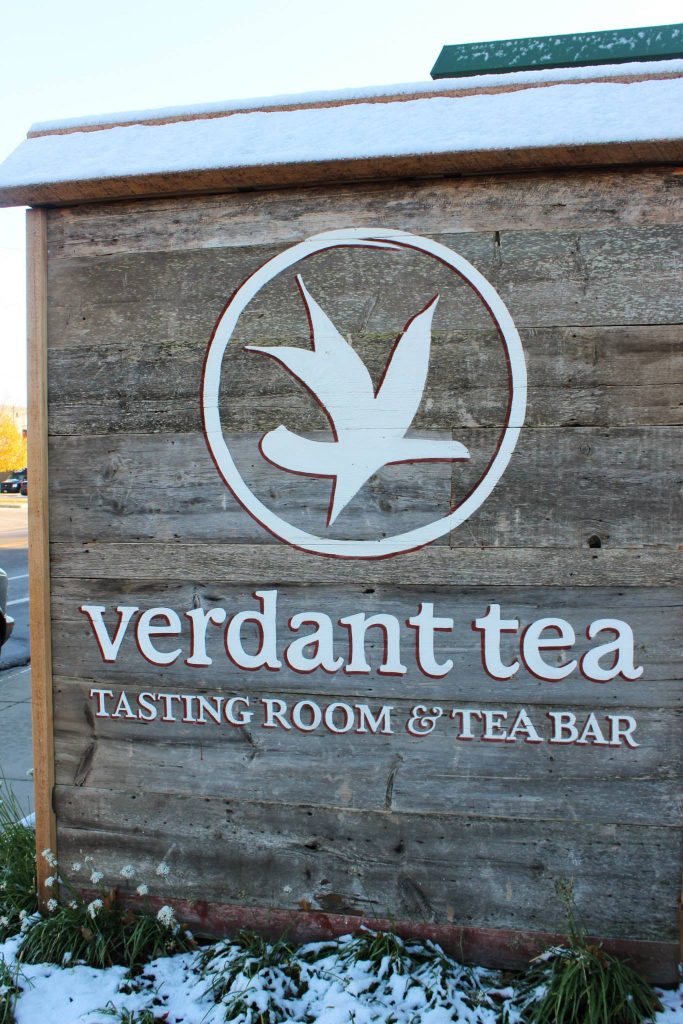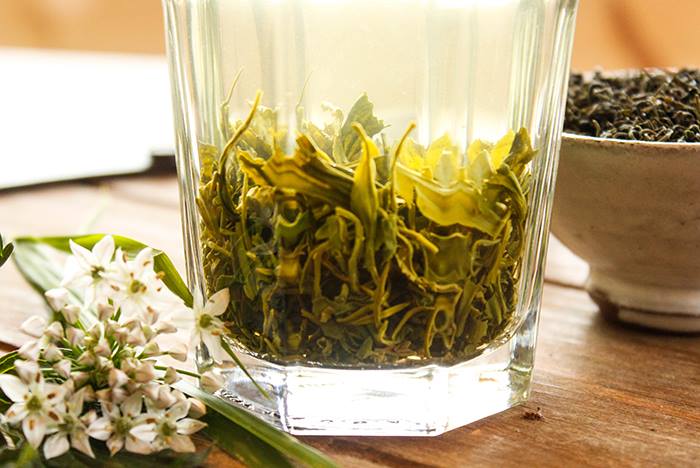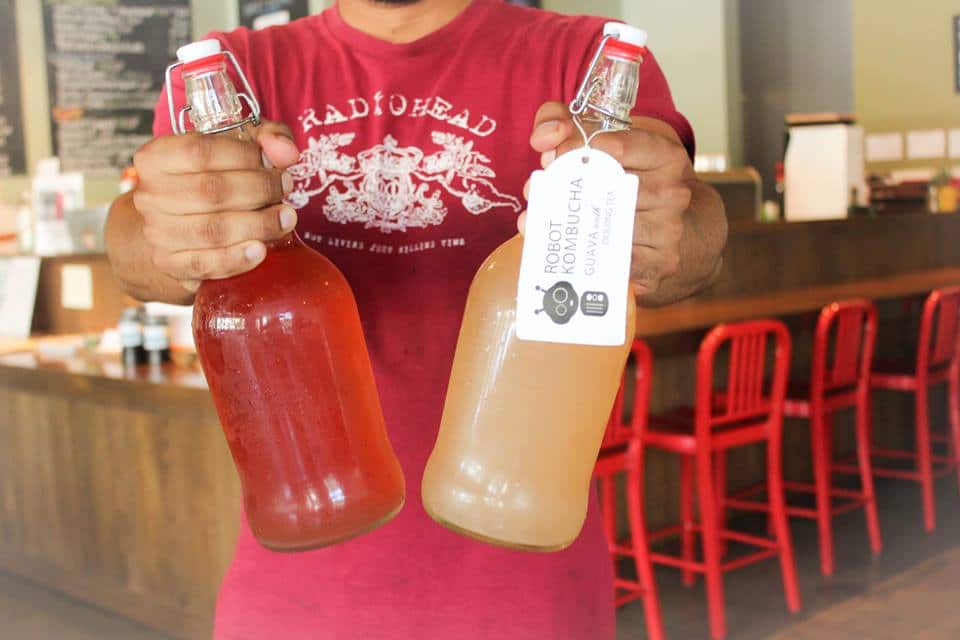After water, tea is the world’s most widely consumed beverage and many countries have made it an integral part of their national identities, traditions and past times. What would an afternoon in England be without crumpets and high tea? How would old men in Turkey spend their day if they didn’t sip strong, black çay as they played backgammon in outdoor cafes?
How can you stomach spicy Indian curries meal after meal, without the promise of snack time washed down with shot glasses of creamy, ultra-sweet — but still a little spicy — cardamom-infused chai? Japan even developed a sacred ceremony around the preparation and serving of the grassy matcha tea. Centuries ago, Americans cared enough about tea to throw boxes of it into the Boston Harbor in protest of the taxation of their beloved drink. These days, in most United States households, you are lucky if you can find a single box of Lipton, collecting dust in the corner cabinet.

Pouring a steeping of tea during a Gong Fu Tea Tasting. Photo courtesy of Verdant Tea.
Cherishing Tea In The Present
David and Lily Duckler, co-owners of Verdant Tea — one of the top things to do in Minneapolis, Minnesota — hope to introduce Americans to the honest and simple offering of hospitality that accompanies a cup of tea. Today I’ll be experiencing this for myself, and hearing the story of Verdant. The Ducklers value transparent sincerity in all aspects of tea production, acquisition and enjoyment.
When you walk into their restaurant, you will notice three wall hangings with smiling Chinese people, picking, pouring or sorting tea. The Ducklers know all of these farmers personally, sourcing all their tea from these small family farms that grow the leaves using traditional, chemical-free agricultural techniques. These Chinese partners never dreamed of exporting their leaves, but were quickly convinced the Ducklers would respect and honor their product.
When asked about tea, Lily instantly smiles, eager to share its magical properties. “Tea is such a communal beverage. You pour a pot of tea and conversation just springs up around this vessel of a tea cup.”
Lily and David are not naïve and know that tea may not be enough to entice people into their restaurant and teashop. They offer a variety of flashier, locally sourced tea-infused treats to encourage curious passerbys to take risks and try something new. A menu of tea-infused beverages including sodas, kambouchas, cocktails and ice cream floats almost overshadow the simple hot teas… until you taste them and their subtle, humble flavor steals the show.

Outdoor Sign. Photo courtesy of Verdant Tea.
Falling In Love With Tea
Believe it or not, the CIA played an integral role in starting Verdant Tea. David first went to China to study international relations with the intent of working for them. In his journey to become fluent, he became interested in Chinese literature and philosophy and flocked to teashops where he could find the nostalgic elements he read about.
“Tea caught my eye when I was there because I loved all the things I read about China. When you go there it’s very loud, noisy, changing all the time, corrupt and confused and big. But when you step into a tea market, it is an entirely different world. Here, people aren’t bartering with you and arguing with you. Instead the first thing someone says when they see you is ‘sit down, have a cup of tea’. You talk about literature, you talk about philosophy, you talk about taste- they all go together and you make new friends”.
David became so enamored with tea that he applied for a grant through the CIA to become fluent in the Chinese language by collecting folk stories about tea, shadowing farmers and translating documents. He returned to the United States to fulfill the terms and conditions of the grant, publishing papers and teaching classes on tea until he realized it wasn’t as much fun talking about tea as it was sharing it with people. This revelation sent him back to China to approach the farmers, who are now his friends, about buying some of the tea.

Small farmer partners hung proudly on the wall of Verdant Tea: the He Family, Master Zhang and Mrs. Li. Photo courtesy of Verdant Tea.
Remembers David, “Fortunately, these farmers were willing to share their tea- it wasn’t that they needed the business- it was more of a cultural exchange for them. We had our first tasting and sold all the tea and we began to think, ‘maybe this is something that people want’ because never before had people brought tea from farms of this size before- 10 to 15 acre farms, not nebulous third world plantations.”
At this point, David pauses to pour us a cup of Dragonwell green tea, one of China’s most popular varieties. He gestures to the picture on the wall of Mrs. Li and explains that she began learning about tea from her father, one of Dragonwell’s preeminent tasters and graders, before she was old enough to talk. The first batch of the spring picking of her tea is of such a high quality that wealthy people use it to bribe governmental officials, even though the light and delicate flavor is too subtle for most Americans to taste.

Mrs. Li’s Spring 2014 Dragonwell Tea. Photo courtesy of Verdant Tea.
I always thought of tea as old, dried out and wrinkly leaves but Lily taught me that teas should be enjoyed fresh. Verdant is one of the tea only companies who dares to air ship leaves so this is actually possible- eight days after the harvest in China, the leaves can be in your cup in Minneapolis. of the leaves the farm, it can be in your cup. When I tried the tea, I tasted a joyful grassy flavor that made me feel like frolicking around a field, like Maria from The Sound of Music. With this tea’s crisp and refreshing flavor, you could feel the energy they absorbed from Longjing Village’s fresh air and sunshine.
With this cup of tea, I understand what made the Ducklers fall in love with tea in the first place. David articulates what I am feeling, saying, “Tea resonated with and inspired us because it is a very simple thing that tastes so good that grabs you and forces you to appreciate humble simple things. When you taste tea like that, other things you think about or when you taste something else or experience something else, you can appreciate really ridiculous things that usually won’t stimulate you. Tea in particular demonstrates our relationship with the world and people around us. If the land is polluted, the tea doesn’t taste good. If people aren’t treated well, they don’t pick it carefully, they don’t finish it properly and it doesn’t taste good. At the end of the day, tea is delicious because it was produced by people who care about their product, and care about you enjoying their product even though they haven’t met you yet”.
Beginning The Business
To encourage fellow Americans to fall in love with tea, the Ducklers started selling these freshly harvested, small farm teas through an online shop. The customers raved about the tea they received but the owners soon missed the human element of sharing tea. With the creation of Verdant’s flagship custom beverage, a chocolaty, malty chai that they sold at Farmers Markets, the Ducklers began to establish more local connections. The chai was microbrewed with Hu family’s best laoshan black tea and herbs, local The Beez Knees and Ames Farms fine, raw honey, herbs and unconventional additions like goji berry, holy basil, saffron and whole vanilla bean. The chai became such a hit at local coffee shops that Verdant needed a larger space to keep up with demand.
Eventually, the Ducklers bought an old warehouse to house their growing operation and wanted to honor the space by opening a full-scale teahouse. Customers loved lingering over tea but the owners soon felt bad about serving tea without having food to accompany it. “You need to serve the needs of your community. How can you be a person in the world if you ignore your friends and the people nearby?”
Initially, Verdant collaborated with the chefs at Birchwood Café, another one of the top things to do in Minneapolis and an 18-year-old establishment. They’ve always been transparent about open-sourcing ingredients for honest and local food. In creating the menu, the owners described their favorite Chinese street food items but encouraged their chefs put their own spin on it and create something new. So although China inspired the menu, Lily and David acknowledge that it is not a Chinese menu,
“Like with our tea, we’re not playing dress up. We are not Chinese and none of our Chefs have direct connections to China. Our main chef is a classically Italian trained chef who dabbled in molecular gastronomy so he’s very high end but he’s interested in creating honest food and that’s the feeling that we latched on too. The feeling of hospitality, creating the kind of delicious, human food that you’d make for good friends when you’re hanging out at home”.

Laoshan House Special is a complete, balanced meal with Chilled Verdant Soup (grilled asparagus & kale), three Gin-Cured Gravlax Sesame Rice Balls and “Ga La” Clams. All centered around fresh Spring 2014 Laoshan Green Tea. Photo courtesy of Verdant Tea.
The menu continues to evolve but features slightly adventurous comfort dishes like “Tea Farmer’s Breakfast” (chicken or tofu potstickers, served with eggs scrambled with oyster mushrooms and stir-fried potato strings with kale and pickled peppers) and the “Laoshan House Dinner Special” (Chilled verdant asparagus & kale soup, gin-cured sesame rice balls and ga la clams with grilled baguette), paired with fresh 2014 spring harvest laoshan green tea.
Tea-Infused Cocktails
In addition to expanding their food menu, Verdant plans to unveil their new cocktail menu in the coming weeks. Henry and Lily brought out some samples, excited to see what I thought. I started with their take on an Old Fashioned, made with a roasted oolong-infused bourbon, saffron infused rum, custom bitters made from Japanese aloes wood and vanilla-almond saffron spice. It tastes like an Old Fashioned but infinitely more complex and I enjoyed the long, roasted aftertaste from tea.
Before the next cocktail, I cleansed my palate with a cup of Master Zhang’s Tieguanyin oolong tea that spiced up the beverage. This tea was made from the same leaves as the Dragonwell but for oolong teas, leaves are intentionally intently bruised to make the juices come out and the folds allow the leaves to oxidize with the air at different rates. The tea takes on a floral, juicy, complex flavor with “roasty toasty undertones” and I could taste the sparkling quality and juiciness that revealed how much Master Zhang loved to make it.
While I paused to appreciate the long finish of the oolong, David popped up to grab the next cocktail, and jokingly apologized with a glint in his eye, “since we’re not serving our cocktails to the public yet, today it seems that I only have the ingredients for our more exoteric ones”. He returned with a sandy colored beverage in one hand and a lit incense stick in the other, whose smoke he circled within my glass. He explained that they developed this drink to show off Japanese aloeswood that featured an aged tea pressed into wood and a sweet scotch. “I’ve never had incense-infused alcohol before,” giggling nervously as I took a sip, paused to think about the interesting flavor and nodded appreciatively.
Lily laughed and explained their philosophy behind their unusual concoctions, “With our cocktails, our goal is to always give people a worthwhile experience. We have things that are a little unusual~ we have, a cocktail with roasted corn and peated scotch, for instance. Some people may say ‘that’s too crazy’ but we want people to explore flavor at their own pace and show them that the world is wide and filled with many delicious things you can taste. Whatever doorway you need, we are going to find that doorway for you- that’s the first little bit. Chai is great and chocolate martinis are delicious but we think that you might want something that stretches you a but without making it scary”.
“So technically, it’s a really classy Old Fashioned. At its heart, an Old Fashioned is an alcohol, simple syrup and bitters and that’s all this is “ In addition to these more esoteric cocktails, aromatic incense-infused things Verdant has more accessible ones, including their version of a Dark and Stormy and the Sir Khan, a creamy, sweet rum beverage. “Keep things accessible, fun and inviting but invite people along this path as far as they want to go. Some people will start with Sir Khan and just stay there and say I love this fuzzy tire. It’s delicious, it’s so sweet and I’m going to drink this forever. But here, the journey can continue- there is no endpoint, just a horizon of more deliciousness.”
With that, she poured me a glass of a Rusty Nail, which had scotch, whiskey, local rosemary-fennel honey, shaken up with a couple drops of blue lotus tinture, which they explained was an extract of a lucid dreaming herb. This simultaneously savory and floral cocktail set off almost every taste bud on my tongue- sweet, sour, salty and a little bit psychedelic.

Homemade Tree Fort soda and Kombucha. Photo courtesy of Verdant Tea.
Non-Alcoholic Tea-Infused Treats
After surviving those crazy cocktails, I cautiously agreed to try the home-brewed kamboucha, slightly sweetened tea fermented using a symbiotic colony of bacteria and yeast. Kamboucha is growing in popularity amongst health and wellness nuts, who rave about its probiotics and immunity-boosting benefits. I had seen pictures of the tea being brewed in garages with sponge-y brain shaped mother yeast colonies and swore I wouldn’t try it.
Most kamboucha producers focus exclusively on the health benefits; however, Verdant combines their best tea leaves with a yeast colony infused with Oregon pinot noir in a simple and non-threatening beverage. The base kamboucha was crisp and sweet and not at all scary. You can try their rotating flavors infused with natural juices, including Pink Robot Guava and Ginger Vesper Fruit.
To finish off this extensive tasting with dessert, Lily brought over some green tea ice cream made by the local Sweet Science Ice Cream, which shares the space with Verdant Tea. These ice creams are made in small batches with all-natural, organic, and local ingredients, and I could taste the sweet green tea we had earlier, complimented by the thick, creamy vanilla base. Just another example of one of Lily and David’s mantras: “It’s not complicated. If you combine two delicious things that are made by passionate people proud of the products they make, it’s bound to be delicious!”
In Closing
After visiting Verdant Tea, David and Lily convinced me that anything that tastes good has to come from a complete supply chain where people love what they do and are treated with respect. The final product celebrates this process. As the Ducklers pointed out, we’re lucky to live in a world where we can source the best ingredients from everywhere and we can be friends with folks in China as well as ones down the street.
To taste the difference of honest and open-sourcing of the best quality ingredients, buy fresh loose leaf tea from Verdant Tea’s online store. If you’re lucky enough to visit their Minneapolis tearoom, make sure to stay for a meal and check their calendar for special events, which include yoga and meditation classes to tastings of tea, chocolate, ice cream and more.
-By Katie Foote

Jessica Festa is the editor of the travel sites Jessie on a Journey (http://jessieonajourney.com) and Epicure & Culture (http://epicureandculture.com). Along with blogging at We Blog The World, her byline has appeared in publications like Huffington Post, Gadling, Fodor’s, Travel + Escape, Matador, Viator, The Culture-Ist and many others. After getting her BA/MA in Communication from the State University of New York at Albany, she realized she wasn’t really to stop backpacking and made travel her full time job. Some of her most memorable experiences include studying abroad in Sydney, teaching English in Thailand, doing orphanage work in Ghana, hiking her way through South America and traveling solo through Europe. She has a passion for backpacking, adventure, hiking, wine and getting off the beaten path.








